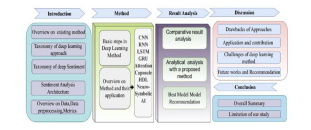Deep Learning for Sentiment Analysis: A Survey
Main Article Content
Abstract
Sentiment analysis, a key area within Natural Language Processing (NLP), is essential for interpreting emotions, opinions, and attitudes expressed in textual content. With the rapid expansion of digital platforms such as social media, online marketplaces, and news portals, efficiently analysing sentiment has become increasingly important for businesses, policymakers, and researchers. However, traditional sentiment analysis techniques, including lexicon-based methods and classical machine learning models, often struggle to address linguistic complexities, contextual dependencies, and variations across different domains. Recent progress in deep learning has transformed sentiment analysis by enabling models to learn intricate language patterns and contextual relationships automatically. Advanced neural network architectures, such as Recurrent Neural Networks (RNNs), Long Short-Term Memory Networks (LSTMs), Convolutional Neural Networks (CNNs), and Transformer-based models like BERT and GPT, have significantly improved sentiment classification accuracy. These deep learning models eliminate the need for extensive manual feature engineering and outperform traditional approaches in understanding nuanced language structures. This paper presents a detailed review of deep learning techniques applied to sentiment analysis. It explores various neural network architectures, compares their performance with traditional methods, discusses commonly used datasets and evaluation metrics, and highlights real-world applications. Additionally, this study examines major challenges in sentiment analysis, such as sarcasm detection, domain adaptation, multilingual processing, and biases in sentiment classification models. Future research opportunities are also discussed, emphasizing hybrid models, transfer learning, explainable AI (XAI), and multimodal sentiment analysis. By offering a structured analysis of deep learning-based sentiment analysis, this survey serves as a valuable reference for researchers and professionals striving to build more efficient, accurate, and scalable sentiment analysis systems. The findings contribute to a broader understanding of how deep learning enhances sentiment analysis and provide insights for future advancements in this evolving field.
